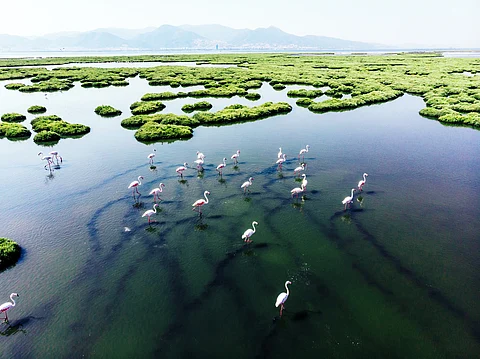

As the UN Biodiversity Conference begins in Cali, Colombia, a recent assessment by 35 per cent ltd, an organisation dedicated to the conservation and sustainable management of natural resources like wetlands, commissioned by Wetlands International, highlighted the critical importance of wetlands in the National Biodiversity Strategies and Action Plans (NBSAP) submitted after the COP15.
Wetlands International's analysis in their report titled Assessing the inclusion of wetlands in NBSAPs provides insights into how effectively the world’s fastest disappearing ecosystem, the wetlands, has been incorporated into NBSAPs worldwide.
The organisation aims to highlight the crucial role that wetland conservation and restoration play in the successful implementation of the Global Biodiversity Plan.
Wetlands are important features in the landscape as they provide services like protecting and improving water quality, providing wildlife habitats, storing floodwaters and maintaining surface water flow during dry periods.
This review was conducted following the COP15, where countries were encouraged to revise their NBSAPs in line with Kunming-Montreal Global Biodiversity Framework (KMGBF). KMGBF was designed to halt and restore biodiversity loss by 2030.
By analysing submissions upto October 8, 2024 the report assessed how well wetlands are represented in these vital documents.
The assessment includes 24 NBSAPs from around the world, representing 12 per cent of the 196 countries that are parties to the Convention on Biodiversity. A majority of submissions came from Europe (10), followed by Asia (7), Africa (2), North America (2), Latin America and the Caribbean (2) and Oceania (1).
Han de Groot, chief executive of Wetlands International, commented on the remarkable recognition of wetlands in these strategies, saying, "It is heartening to see such a significant number of national nature plans acknowledging the vital role wetlands play. These ecosystems support 40 per cent of the world's biodiversity, yet they are disappearing faster than any other ecosystem. Therefore, it is essential that wetlands are effectively incorporated into global and national biodiversity plans".
The report revealed several key findings regarding the inclusion of wetlands in the national plans. As much as 83 per cent of the submitted NBSAPs explicitly mention wetlands, inland waters or freshwater in their targets.
Specifically, submissions from Africa and Oceania reported 100 per cent mention rate for these terms, while over 90 per cent of European nations included them as well.
Wetlands are identified under key targets related to KMGBF, for example, 71 per cent of the plans articulate specific measures for restoration (Target 2) and 50 per cent include protection for these important ecosystems (Target 3). However, the report noted that fewer NBSAPs provide specific, measurable targets, indicating a need for improvement in those areas.
Moreover, the review found that 16 NBSAPs mentioned specific wetland types, including mangroves, rivers, lakes and peatlands. Among these, mangroves, rivers and lakes received the highest mentions, indicating their importance in various environmental targets.
Significant wetland areas such as Amazon River Basin and the Hudson Bay Lowland were seldom specifically mentioned in relation to national targets.
Although these regions are important for biodiversity, climate regulation and ecosystem services, they largely remained unaddressed in official national strategies.
The report emphasised the need for countries to enhance the integration of wetlands within national biodiversity targets, establishing clear, measurable goals for wetland restoration and protection.
Focusing on important wetland areas in national strategies will also support regional and global ecological health and preserve biodiversity.
This assessment serves as a wakeup call to nations worldwide on the importance of wetlands in achieving biodiversity goals. As we begin with COP16, it is vital for countries to take bolder actions in conserving these critical ecosystems, which will benefit both nature and communities who rely on them.